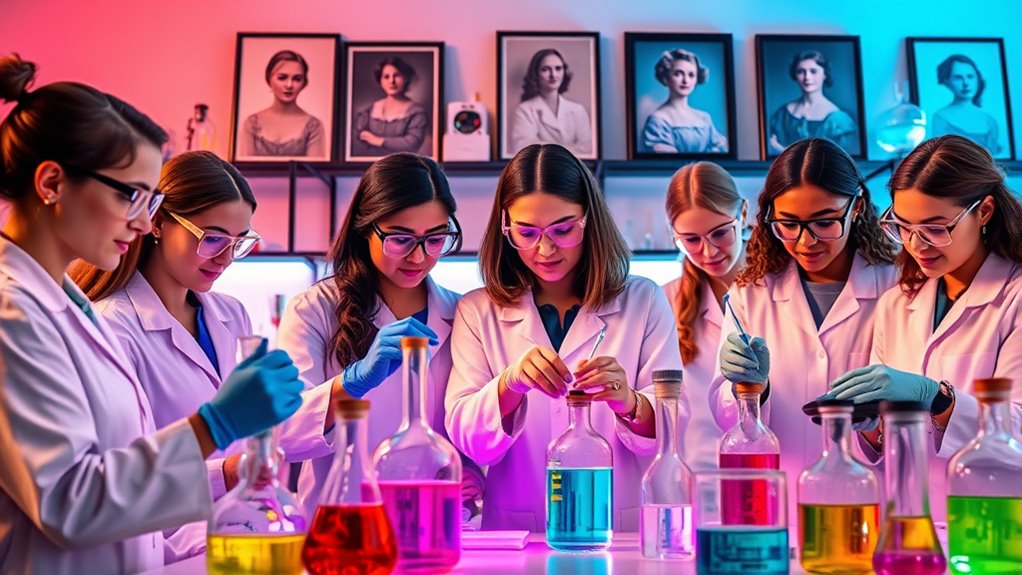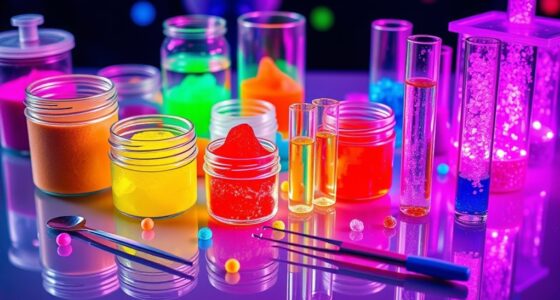Women in chemistry have made major breakthroughs, from Marie Curie’s discovery of radioactivity to Rosalind Franklin’s contributions to DNA’s structure. They’ve broken barriers in education, led innovations in medicine, and continue to shape the future with advances in technology. As more women take on leadership roles and inspire new generations, exploring their stories reveals how they’re transforming the field. Keep exploring to learn more about these inspiring scientists and their remarkable achievements.
Key Takeaways
- Women like Marie Curie and Rosalind Franklin have made groundbreaking discoveries shaping modern chemistry and medicine.
- Pioneers such as Rachel Lloyd and Marie Maynard Daly broke barriers in education and leadership for women of color in science.
- Modern female scientists lead innovations in cancer research, sustainable materials, and advanced analytical techniques.
- Women in chemistry face ongoing challenges like underrepresentation and gender bias, but support programs foster growth and inclusion.
- Celebrating women’s contributions inspires future generations and highlights the importance of diversity in scientific progress.
Trailblazing Women Who Shaped Scientific Discoveries

Women have played an essential role in shaping scientific discoveries in chemistry. You see, trailblazing women like Marie Curie broke barriers by pioneering radioactivity research and discovering polonium and radium, opening new frontiers in nuclear science. Since 1901, 65 women have been awarded Nobel Prizes, showcasing the recognition of their groundbreaking work. Dorothy Crowfoot Hodgkin made critical advances by uncovering the structures of important biomolecules, such as penicillin and insulin, transforming biological chemistry. Rosalind Franklin’s work with X-ray crystallography greatly contributed to understanding DNA’s structure, even if she didn’t receive full credit initially. Despite societal obstacles, these women’s perseverance led to their recognition, with 65 women earning Nobel Prizes since 1901. Their pioneering efforts not only advanced science but also paved the way for future generations of women in chemistry, inspiring others to push boundaries and challenge norms.
Groundbreaking Contributions to Medical and Biological Chemistry

Groundbreaking contributions to medical and biological chemistry have transformed healthcare and our understanding of life processes. Marie Curie’s discoveries of radium and polonium paved the way for cancer treatments and improved x-ray technology, saving countless lives. Her pioneering research laid the foundation for radiotherapy and nuclear medicine, which are now vital components of modern cancer care. Rachel Lloyd, the first American woman with a chemistry doctorate, advanced research on sugar beets, influencing nutrition and food safety. Clara Immerwahr’s early work in Germany highlighted women’s essential role in scientific progress. Mary Engle Pennington applied chemistry to develop safer food processing methods, directly impacting public health. Agnes Pockels’ surface chemistry research shed light on biological systems. These women’s achievements underpin modern medical technologies like biosensors, diagnostics, and targeted therapies. Their pioneering work continues to inspire new directions in biochemistry, shaping the future of medicine and biological research. Additionally, understanding the role of women in science helps recognize the importance of diversity in driving innovation and scientific discovery.
Pioneers Breaking Barriers in Education and Leadership

Trailblazing women in chemistry have made significant strides in education and leadership, breaking down longstanding barriers. Rachel Holloway Lloyd became the first American woman to earn a doctorate in chemistry, paving the way for others. Her influence helped the University of Nebraska admit women into graduate programs, with over 20% of students being women between 1888 and 1915.
Lloyd’s leadership extended to founding scientific societies and advocating for women’s participation in STEM. Women like Rosa Bouton and Mary Fossler shifted from students to faculty, promoting female involvement in academia. Irène Joliot-Curie’s Nobel-winning research demonstrated women’s capacity for groundbreaking science.
Marie Maynard Daly broke racial and gender barriers as the first African-American woman with a chemistry PhD, further inspiring future generations of women in leadership roles. Increasing awareness of networking solutions and supportive communities has also played a role in empowering women pursuing careers in chemistry.
Modern Innovators Transforming the Field With New Technologies

Today’s leaders in chemistry are pushing the boundaries of innovation through advanced technologies and interdisciplinary approaches. You see women scientists leading breakthroughs in cancer research by targeting the circadian clock, integrating chronobiology with precision medicine. They’re employing bioinformatics and chemical biology to identify new molecular targets, designing drugs that disrupt tumor growth cycles efficiently. Women in molecular sciences are increasingly recognized for their critical contributions to cutting-edge research. In materials science, women like Uma Chowdhry are developing sustainable materials—superconductors, photovoltaics, biofuels—that enhance energy efficiency and reduce environmental impact. Analytical techniques have advanced with women driving innovations in spectroscopy and imaging, enabling precise molecular analysis essential for drug discovery. Additionally, female researchers harness computational chemistry and AI to predict behaviors, accelerate materials discovery, and optimize synthetic processes. Their interdisciplinary work is transforming chemistry into a more precise, sustainable, and innovative field, with wall organization systems supporting efficient laboratory and workspace management.
The Future of Women in Chemistry: Opportunities and Challenges

As the landscape of chemistry continues to evolve, women have increasing opportunities to shape the future of the field through leadership, innovation, and collaboration. You can explore diverse roles, from research to industry and academia, with many job openings in R&D, senior chemist, and more. Careers in chemicals offer a wide range of pathways for women to advance their expertise and influence. Advances in STEM education and mentorship programs support your growth, while industry partnerships provide pathways for career development. Despite progress, challenges like underrepresentation, gender bias, and work-life balance remain. However, initiatives focused on diversity, leadership, and networking are creating new growth areas. The future promises more women taking on influential roles, driving innovation, and shaping policies. Your participation will help break barriers, expand opportunities, and ensure a more inclusive, dynamic chemistry community.
Frequently Asked Questions
How Have Women in Chemistry Influenced Environmental Science and Sustainability Efforts?
You see, women in chemistry have profoundly impacted environmental science and sustainability. They pioneered sanitation and water quality standards, pushed for eco-friendly practices, and advanced green chemistry.
By developing innovative pollution-monitoring techniques, biodegradable materials, and climate change strategies, they shape a healthier planet. Despite challenges, these women’s efforts inspire societal change and policy development.
Ensuring a sustainable future where environmental protection becomes a shared priority.
What Initiatives Support Young Women Pursuing Careers in Chemical Research Today?
Think of the torch passed from Marie Curie to today’s young women in chemistry. You’re supported by initiatives like scholarships, internships, and targeted research funding that help build your confidence and skills.
Organizations offer mentorship, professional development, and early outreach programs to inspire you to pursue research careers. These efforts aim to break barriers, foster inclusion, and guarantee you have the resources and encouragement to make your mark in chemical science.
How Does Gender Diversity Impact Innovation in Chemical Sciences?
Gender diversity boosts innovation in chemical sciences by fostering a wider range of ideas and problem-solving approaches. When you work in diverse teams, you’ll notice increased creativity and disruptive thinking, leading to breakthroughs.
Your collaboration with different genders encourages multiple perspectives, which enhances research quality. Promoting inclusivity and balanced representation not only strengthens team dynamics but also accelerates scientific advancement.
Making the field more innovative and impactful for everyone involved.
What Are the Most Common Challenges Women Face in Advanced Chemical Research Fields?
You face a landscape riddled with invisible barriers and stormy waters. Women in advanced chemical research often struggle against structural hurdles like insecure funding, the “publish or perish” race, and inconsistent mentorship.
The workplace feels like a glass maze, with underrepresentation, bias, and microaggressions blocking your path. Balancing work and life becomes a tightrope walk, especially with limited support.
These challenges threaten your progress and visibility in a competitive, often unwelcoming environment.
How Can International Collaboration Enhance Opportunities for Women Chemists Worldwide?
International collaboration boosts opportunities for women chemists by expanding access to global networks, funding, and research facilities. You can participate in international conferences, joint projects, and educational programs that increase visibility and build your skills.
These partnerships promote inclusivity, help you stay current with advances, and open doors to leadership roles. By working across borders, you’re more likely to find support, mentorship, and resources essential for advancing your career in chemistry.
Conclusion
As you celebrate these incredible women, realize their impact is nothing short of revolutionary—shaping the very fabric of chemistry itself. Their breakthroughs have shattered ceilings you once thought were unbreakable, paving the way for a future where gender no longer defines potential. So, when you stand on the shoulders of these giants, remember: their courage and innovation are transforming the world at a rate that’s almost beyond imagination. The future is yours to create—be bold.









